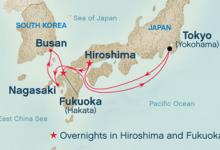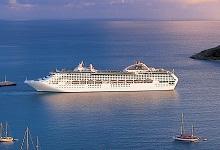Recently Viewed Cruises
- Sun, Golden Week ex Yokohama ReturnAdd to favourites
- Shadow, Voyage 3311 ex Hong Kong to TokyoAdd to favourites
- Pacific Princess, World Cruise 2013 Sector ex Sydney to Hong KongAdd to favourites
- Pacific Princess, World Cruise 2013 Sector ex Sydney to DubaiAdd to favourites
- Pacific Princess, World Cruise 2013 Sector ex Sydney to VeniceAdd to favourites
- Oceanic Discoverer
- Ab Fab Oosterdam
- Catch up on Cruising: Latest cruise news in bite size
- Catch up on Cruising: Latest cruise news in bite size
- Catch up on Cruising: Latest cruise news in bite size
- Frequently Asked Questions
-
Sun, Golden Week ex Yokohama Return
Nights 9 Ship Sun Princess Star Rating 
Departs Yokohama, Japan Sailing 2013: 27 Apr Ports of Call Yokohama, Hiroshima, Nagasaki, Busan, Hakata Please enquire about this cruise for pricing.
9 Night Cruise sailing from Yokohama roundtrip aboard Sun Princess.
Sun Princess - along with its sister ships Dawn and Sea - has more than 400 balcony staterooms, so you can wake up to your own exclusive vista. Take a dip in one of three spacious pools or spend your evening at one of the show lounges with unique performances each night. Dining options are also plentiful, including two formal dining rooms, the Sterling Steakhouse and the 24-hour Horizon Court. And don't miss the Lotus Spa for some pampering.
Highlights of this cruise:
Yokohama
Yokohama and Edo began life as sleepy fishing villages. That changed in the early 17th century after Tokugawa Ieyasu became Shogun. Edo became the center of political power in Japan, a position the city retained even after the restoration of Imperial rule in 1866.
Contemporary Tokyo may be the most astonishing city on earth. It's a paradoxical mix of ancient tradition and postmodern culture. The Ginza - an international shopping mecca - stands near the serene grounds of the Imperial Palace, and the hyper-speed of 21st century consumerism is mysteriously reconciled with the elegance and serenity of traditional culture. Tokyo provides the traveler with a dizzying experience.
With the Meiji Restoration of 1868, Edo was renamed Tokyo, the "Eastern Capital," to distinguish it from the old imperial capital at Kyoto, the "Western Capital."
Hiroshima
On August 6, 1945, human history was irrevocably altered when the American bomber Enola Gay dropped an atomic bomb on Hiroshima. The bomb was code-named "Little Boy," but its detonation left half the city in ruins and aflame. Today, Hiroshima is a monument not only to the destructive forces harnessed by men but also to the indomitable will of the human spirit to overcome tragedy. At the heart of the city lies Peace Memorial Park and the Atomic Bomb Dome. The gutted walls of the city's old Industry Promotion Hall and the skeletal frame that supported its copper dome, vaporized in the blast, are instantly recognizable symbols of Hiroshima.
Travelers to Hiroshima will discover a more serene note at nearby Miyajima Island. One of the top-three scenic spots of Japan, the island is home to ancient Itsukushima Shrine, a designated National Treasure.
Nagasaki
For most travelers, Nagasaki is a symbol of the horror and the inhumanity of war. An estimated 75,000 people perished in 1945 when the city became the second target of a nuclear attack. Today, Nagasaki's Peace Park and Atomic Bomb Museum draw visitors from around the world.
But this beautiful city on Kyushu offers other sights. Often described as the San Francisco of Japan, the city occupies verdant hills surrounded by a deep-water bay. For three centuries, Nagasaki was Japan's sole window on the world. The city is also celebrated as the setting for Puccini's opera "Madame Butterfly."
Busan
The second largest city in South Korea, Busan is your gateway to a fascinating land whose culture is a unique amalgam of old and new. Modern high-rise towers dwarf ancient Buddhist temples. The city's bustling business district offers a stark contrast to the serene grounds of Yongdusan Park. In short, Busan is a microcosm of South Korea, a nation whose startling economic success often obscures one of Asia's most sophisticated and venerable cultures.
Busan was the scene of bitter fighting during the Korean War. The United Nations Memorial Cemetery marks the final resting place for the troops from 16 nations who gave their lives during the conflict.
Hakata
Since 1889, the old port of Hakata has been part of Fukuoka city, the major commercial center of Northern Kyushu. This region is perhaps the oldest settled area in Japan, and for centuries Hakata served as Japan's cultural and commercial gateway with China and Korean. The twin cities played another major role in Japanese history - it was here that Kublai Khan launched his two invasions of Japan in the 13th century. Two anchor stones from the great Mongol fleet destroyed by the famous typhoon or Kamikaze are still on display at Hakata's 8th century Kushida Shrine. Beyond the hustle and bustle of today's modern metropolis, visitor will still discover and enjoy the serenity of ancient shrines, superb formal gardens, and a duo of fascinating museums.
When Hakata and Fukuoka merged in 1889, the combined metropolis was to be named Hakata. Until a group of disaffected samurai from Fukuoka - an important castle town in feudal times - intervened to ensure the new city's name honored their old home.







